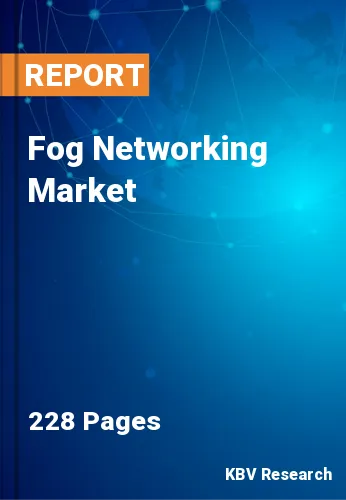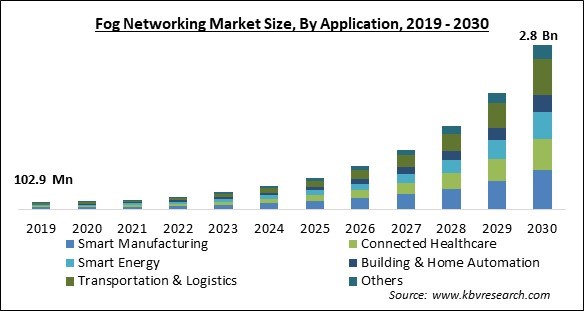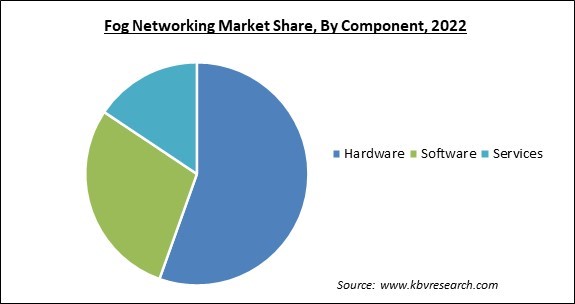
The Global Fog Networking Market size is expected to reach $2.8 billion by 2030, rising at a market growth of 38.7% CAGR during the forecast period.
Fog networking may be used in the context of linked healthcare to get around some drawbacks and difficulties in conventional cloud-based systems. Therefore, the connected healthcare segment would register approximately 1/5th share of the market by 2023. By leveraging local network resources, fog networking may increase the dependability and resilience of healthcare systems. Moreover, there are a lot of prospects for fog computing adoption in the APAC region due to its large population and growing urbanization, notably in industries like smart cities, transportation, manufacturing, and healthcare. The APAC region captured $59,485.1 million revenue in 2022. In order to improve operational efficiency, take advantage of real-time data analytics, and meet the rising demand for connected devices and IoT applications, businesses in the Asia-Pacific region are progressively using fog networking solutions. Some of the factors impacting the market are incorporation of new technology in the integration, improvements to the edge computing infrastructure, and Professional and skill gaps.

Effective and decentralized data processing at the network edge becomes critical as new technologies like the Internet of Things (IoT), edge computing, and artificial intelligence (AI) evolve. To open up even more possibilities, fog networking may be integrated with other cutting-edge technologies like 5G networks, machine learning, and blockchain. Ultra-low latency applications, for instance, are made possible by combining fog computing with 5G. In contrast, AI and machine learning at the edge make real-time data analysis and decision-making possible. Moreover, Fog computing is a distributed computing paradigm that moves computation and data storage closer to the network's edge. It has gained traction due to the explosive growth of Internet of Things (IoT) devices and the demand for real-time data processing. Edge computing infrastructure improvements have certainly played an essential part in driving the market. Edge computing reduces latency and enables quicker reaction times by processing and analyzing data closer to the devices that generated it. Consequently, the integration of developing technologies with the market and Edge computing infrastructure improvements expected to have a significant positive impact on innovation and the development of a more intelligent and linked digital environment.
However, the implementation of fog computing, which involves bringing the capabilities of cloud computing to the periphery of a network, calls for the possession of specific skills and information in fields such as data analytics, networking, and data security. As a result of the fact that fog computing is still a relatively young and developing industry, there is a shortage of experts who have experience in this area. Therefore, tackling the talent gap through training programs and educational activities is essential to unleashing the true potential of fog networking and driving its commercial expansion. This can be accomplished by addressing the skill gap.
Based on component, the market is segmented into hardware, software, and service. The hardware segment registered the highest revenue share in the market in 2022. This may be due to the growing use of fog networking tools and apparatus, including edge servers, routers, gateways, and sensors. The connection, data processing, and communication necessary for fog computing are made possible by the hardware components.

On the basis of application, the market is categorized into smart manufacturing, connected healthcare, smart energy, building & home automation, transportation & logistics, and others. The transportation & logistics segment covered a considerable revenue share in the market in 2022. This is since the transportation and logistics sector is undergoing a sizeable digital transition and using fog networking technologies to increase overall efficiency, optimize supply chain management, and expedite logistical operations.
| Report Attribute | Details |
|---|---|
| Market size value in 2022 | USD 209.3 Million |
| Market size forecast in 2030 | USD 2.8 Billion |
| Base Year | 2022 |
| Historical Period | 2019 to 2021 |
| Forecast Period | 2023 to 2030 |
| Revenue Growth Rate | CAGR of 38.7% from 2023 to 2030 |
| Number of Pages | 228 |
| Number of Table | 290 |
| Report coverage | Market Trends, Revenue Estimation and Forecast, Segmentation Analysis, Regional and Country Breakdown, Companies Strategic Developments, Company Profiling |
| Segments covered | Component, Application, Region |
| Country scope | US, Canada, Mexico, Germany, UK, France, Russia, Spain, Italy, China, Japan, India, South Korea, Singapore, Malaysia, Brazil, Argentina, UAE, Saudi Arabia, South Africa, Nigeria |
| Growth Drivers |
|
| Restraints |
|
Region wise, the market is analyzed across North America, Europe, Asia Pacific, and LAMEA. The North America region dominated the market with the maximum revenue share in 2022. This is explained by the region's technologically sophisticated environment, which greatly focuses on innovation and the early adoption of developing technology. Due to enterprises in North America realizing the potential of fog networks to provide real-time data processing, lower latency, and increase overall network efficiency, this has opened up a broad range for the adoption of fog computing solutions, further increasing the region's development.
Free Valuable Insights: Global Fog Networking Market size to reach USD 2.8 Billion by 2030
The market research report covers the analysis of key stake holders of the market. Key companies profiled in the report include Cisco Systems, Inc., IBM Corporation, Huawei Technologies Co., Ltd. (Huawei Investment & Holding Co., Ltd.), Google LLC (Alphabet Inc.), Microsoft Corporation, Fujitsu Limited, Dell Technologies, Inc., Intel Corporation, Amazon Web Services, Inc. (Amazon.com, Inc.) and Arista Networks, Inc.
By Application
By Component
By Geography
The Market size is projected to reach USD 2.8 billion by 2030.
Incorporating new technology in the integration are driving the Market in coming years, however, Professional and skill gaps restraints the growth of the Market.
Cisco Systems, Inc., IBM Corporation, Huawei Technologies Co., Ltd. (Huawei Investment & Holding Co., Ltd.), Google LLC (Alphabet Inc.), Microsoft Corporation, Fujitsu Limited, Dell Technologies, Inc., Intel Corporation, Amazon Web Services, Inc. (Amazon.com, Inc.) and Arista Networks, Inc.
The expected CAGR of this Market is 38.7% from 2023 to 2030.
The Smart Manufacturing segment is leading the Market by Application in 2022; thereby, achieving a market value of $667.8 million by 2030.
The North America region dominated the Market by Region in 2022 and would continue to be a dominant market till 2030; thereby, achieving a market value of $999.3 million by 2030.
Our team of dedicated experts can provide you with attractive expansion opportunities for your business.
